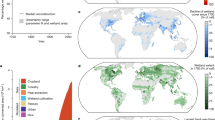Abstract
The hydrology of wetlands is dynamic owing to daily, seasonal, and inter-annual changes in water levels caused by tides, river flooding, and/or precipitation events. The resulting water regimes are primary determinants of many wetland ecosystem attributes including soil properties, water chemistry and biotic composition. Human-caused changes to wetlands that result in anomalous water regimes usually trigger a cascade of ecological effects, including species losses and invasions and altered biogeochemical cycles.These, in turn, often cause a loss in ecosystem services. Compared to other ecosystems, rates of wetland degradation and loss have been greater, primarily due to six drivers: 1) infrastructure development, 2) land conversion, 3) water withdrawal, 4) eutrophication and pollution, 5) overharvesting and overexploitation, and 6) introduction of invasive species. Wetland degradation is often caused by multiple drivers, some of which are site based, while others are regional or global in scope. This makes wetland degradation difficult to reverse, even where social and institutional support is strong. However, in the past twenty years, the complexity and scale of wetland restoration has advanced, resulting in successful attempts in many different contexts around the world. In many cases, though, it is not possible to fully restore the water regime of a wetland modified by human use, so partial fixes must be accompanied by ongoing water level management to achieve desired conditions. An important future challenge is to develop and implement strategies that ensure the sustainability of wetland ecosystem services under increasing stress from climate change, increasing human population and the drivers that have historically threatened wetlands.
Similar content being viewed by others
References
Beilfuss RD, Barzen JA. Hydrological wetland restoration in the Mekong Delta, Vietnam. In: Mitsch WJ, editor. Global wetlands: old world and new. Amsterdam: Elsevier Science B.V; 1994.
Duever MJ. Big Cypress regional ecosystem conceptual ecological model. Wetlands. 2005;25:843–53.
Galatowitsch SM. Ecological restoration. Sunderland: Sinauer Associates; 2012. p. 2012.
Galatowitsch SM, van der Valk AG. Characteristics of recently restored wetlands in the Prairie Pothole Region. Wetlands. 1999;16:75–83.
Galloway JN, Cowling EB. Reactive nitrogen and the world: 200 years of change. Ambio. 2002;31(2):64–71.
Hinga KR, Batchelor A. Waste detoxification. In: Hassan R, Scholes R, Nash A, editors. Millennium ecosystem assessment volume 1: conditions and trends working group. Washington, DC: Island Press; 2005.
Johnston CA. Wetland losses due to row crop expansion in the Dakota Prairie Pothole Region. Wetlands. 2013;33:175–82.
Millennium Ecosystem Assessment. Ecosystems and human well-being: wetlands and water synthesis. Washington, DC: World Resources Institute; 2005.
Nilsson C, Berggren K. Alterations of riparian ecosystems caused by river regulation: dam operations have caused global-scale ecological changes in riparian ecosystems. How to protect river environments and human needs of rivers remains one of the most important questions of our time. BioScience. 2000;50:783–92.
Oslund FT, Johnson RR, Hertel DR. Assessing wetland changes in the Prairie Pothole Region of Minnesota from 1980–2007. J Fish Wildl Manag. 2010;1:131–5.
van der Valk AG. The biology of freshwater wetlands. 2nd ed. Oxford: Oxford University Press; 2012.
Wissinger SA. Ecology of wetland invertebrates. Synthesis and applications for conservation and management. In: Batzer DP, Rader RB, Wissinger SA, editors. Invertebrates in freshwater wetlands of North America. Ecology and management. New York: Wiley; 1999. p. 1043–86.
Author information
Authors and Affiliations
Corresponding author
Editor information
Editors and Affiliations
Rights and permissions
Copyright information
© 2018 Springer Science+Business Media B.V., part of Springer Nature
About this entry
Cite this entry
Galatowitsch, S.M. (2018). Natural and Anthropogenic Drivers of Wetland Change. In: Finlayson, C., Milton, G., Prentice, R., Davidson, N. (eds) The Wetland Book. Springer, Dordrecht. https://doi.org/10.1007/978-94-007-4001-3_217
Download citation
DOI: https://doi.org/10.1007/978-94-007-4001-3_217
Published:
Publisher Name: Springer, Dordrecht
Print ISBN: 978-94-007-4000-6
Online ISBN: 978-94-007-4001-3
eBook Packages: Biomedical and Life SciencesReference Module Biomedical and Life Sciences




